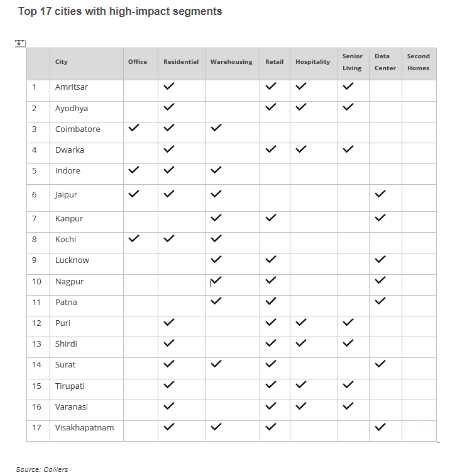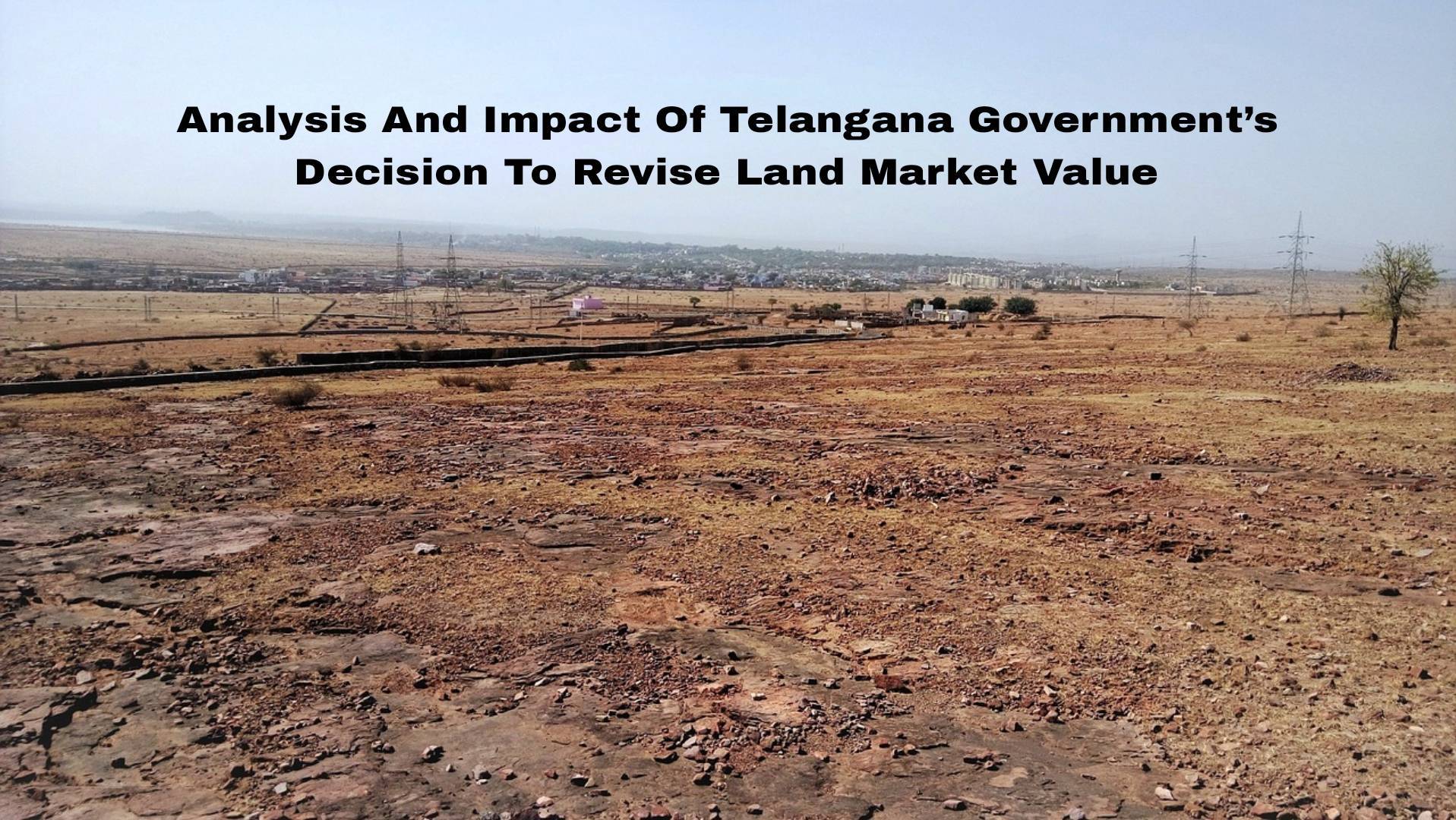As India marches towards becoming the world's third-largest economy, emerging cities are poised to play a critical role in the nation's growth trajectory. By 2050, India is expected to have nearly 100 cities with populations exceeding one million, in addition to its eight mega-cities. Key factors such as infrastructure development, digitization, tourism, and changes in the office landscape will drive the next wave of urban growth across these locations. Taking aforementioned factors as primary considerations, Colliers identified and evaluated over 100 such emerging cities to determine their real estate attractiveness and growth potential over the next 5-6 years in its latest report "Equitable Growth and Emerging Real Estate Hotspots."
A comprehensive analysis of these cities was done involving assessment of various social, economic, financial, and real estate specific demand & supply side parameters. Colliers conducted a broad-based assessment and developed an objective framework incorporating the above-mentioned parameters to assess their relative degrees of importance and impact on various real estate segments such as office, residential, warehousing, retail, hospitality, and alternatives (data centers, senior living, second homes etc.) in the respective cities.
This detailed analysis aided in identification of 30 potentially high growth cities from the universe of 100+ cities where real estate development is set to strengthen in the medium to long term. Interestingly, 17 of these 30 high-potential cities are expected to witness accelerated real estate development across three or more asset classes. A geographical spread of these 17 high-impact emerging real estate hotspots highlights equitable growth across the Northern, Southern, Western, Eastern, and Central regions of the country.


Note: The real estate impact in a particular city/location is an indication of real estate asset performance in the next few years compared to current level activity in the city/location. It does not represent activity comparison between different cities/locations. Of the 30 high potential cities, 17 cities are expected to witness moderate to high impact in at least 3 asset classes. The rest, meanwhile, are expected to witness heightened activity up to 2 asset classes only.
“Smaller towns are emerging as dynamic contributors to India's economy, driven by improved infrastructure, affordable real estate, skilled talent, and government initiatives. This growth is set to propel the real estate sector to an estimated USD 1 trillion by 2030 and potentially USD 5 trillion, a 14-16% share in GDP by 2050. Significant momentum is expected across residential, commercial, retail, hospitality, and industrial segments. Additionally alternate asset classes such as data centers, senior living, and second homes are also poised for significant activity in these emerging real estate hotspots.” said Badal Yagnik, Chief Executive Officer, Colliers India
All throughout, infrastructure growth will remain a key catalyst for the real estate development across India. Enhanced connectivity and increased manufacturing activity driven by flagship infrastructure projects under National Infrastructure Pipeline (NIP) and PM GatiShakti will lead to the dispersion and expansion of growth centers beyond Tier I cities. This will significantly boost the economies of smaller towns, triggering real estate activity across warehousing and residential segments particularly. Further, the overall supportive environment for the development of factories and MSMEs, will lead to increased warehousing requirements across emerging hotspots within infrastructure corridors. To assess the overall impact of infrastructure on real estate, Colliers’ analysis involved various demand and supply side parameters, including proximity to key infrastructure projects, warehouse concentration & MSME registrations in the locations and infrastructure allocations in the city etc.
Evolving work models and Technology sector to propel office and residential demand in emerging cities
Owing to the rising prevalence of hybrid working, companies are increasingly adopting hub and spoke model, establishing satellite offices in smaller towns. Colliers identified the high impact locations through a comprehensive analysis evaluating multiple parameters including current technology landscape & start-up ecosystem, availability of skilled talent, current and proposed infrastructure upgrades, and proximity to established office markets. Coimbatore, Indore and Kochi, amongst others emerged as locations having high potential as satellite office markets.
"As tech giants and innovative start-ups tap into the skilled talent pools of emerging hubs, smaller cities are on the brink of a transformative boom in both office and residential markets. Office rental arbitrage, typically 20-30% lower and relatively affordable housing market in these locales creates a win-win scenario for companies and employees alike. This surge in demand is set to ignite a wave of interest from leading real estate developers, ushering in an influx of high-quality supply in these markets. Moreover, the rise of flex spaces in these vibrant hubs will seamlessly bridge the demand-supply gap for premium office spaces, fostering a new era of growth and opportunity." says Vimal Nadar, Senior Director & Head of Research, Colliers India.
Increased digital penetration to spur data center growth in smaller towns
Increased digitization is set to significantly boost real estate activity in smaller towns, particularly in warehousing and data centers. The growth of e-commerce will facilitate the expansion of online retail platforms, leading to the development of fulfillment centers, warehouses, and distribution hubs in strategic locations. Additionally, the surge in data consumption will drive the development of data centers and smart infrastructure in these emerging cities, which will enhance the overall attractiveness of these towns for real estate investments.
Colliers’ analysis on digitization and real estate impact included population, GDP per capita, propensity to purchase online, digital payment adoption, existing presence of top retail brands etc. Jaipur, Kanpur, Lucknow, Nagpur, Patna, Surat and Visakhapatnam featured prominently in the list of cities expected to witness heightened digitization driven real estate activity.
Spiritual tourism to fuel growth of temple towns
Bolstered by government policy support and infrastructure developments, spiritual tourism is poised to be a critical growth driver for the development of several temple towns in India. Upgrades in infrastructure and enhanced connectivity through improved roads, flagship trains, and new airports have the potential to attract organized real estate players to these spiritual destinations in the long term, specifically across hospitality and retail segments. Identification of high impact locations with respect to spiritual tourism involved analysis of multiple parameters including sanctioned allocations under various government programs, annual tourist footfalls in primary pilgrimage site, upcoming plans of real estate developers and land price appreciation. Amritsar, Ayodhya, Dwarka, Puri, Shirdi, Tirupati and Varanasi emerged as cities to watch out for in terms of growth driven by spiritual tourism.
Conclusion
The profound transformation underway in India's real estate landscape, driven by factors such as infrastructure development, digitization, and tourism. It underscores the expanding role of emerging cities, which are poised to become pivotal in the nation's economic growth trajectory. With a forecast of nearly 100 cities exceeding one million in population by 2050, alongside significant investments in infrastructure and evolving work models, these cities are set to play a crucial role in shaping India's urban future. The rise of smaller towns as dynamic economic contributors, supported by favorable government policies and technological advancements, signals a shift towards decentralized growth hubs. Overall, this trend highlights opportunities for diverse real estate investments across residential, commercial, hospitality, and industrial sectors, driven by evolving consumer needs and enhanced connectivity.









.png)